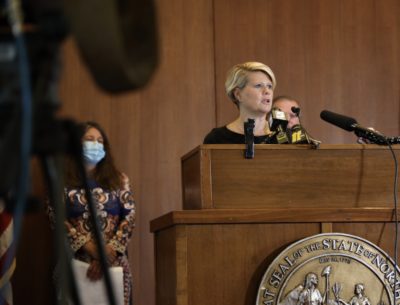

How much to pay public school teachers remains a hardy perennial of North Carolina politics and budget-making. The issue will arise anew in 2021 as a test of whether the governor and legislators find a path to adopting broad, long-range strategy even as they wrestle with the consequences of a still-surging coronavirus.
The Southern Regional Education Board offers data as context for the challenges ahead in a recent posting of a “teacher compensation dashboard” on its website, along with accompanying analyses. The SREB, founded in 1948, has long worked across Democratic-Republican and governor-legislator lines in its 16-state region.
While providing state-by-state data on salary, health coverage, and retirement benefits, the SREB does not rank the states on average teacher pay. Rather, it spotlights how far short each Southern state falls on paying teachers in comparison with similar professionals.
In North Carolina, says the SREB, teachers earn 25.3% per week less than “similarly educated peers.” For comparison among neighboring states, South Carolina falls 13.1% short, Tennessee 21.4%, Georgia 25%, Virginia 32.7%.
Using 2018-19 salaries, SREB reports North Carolina’s top average teacher salary at $62,469, below South Carolina at $73,269 and Georgia at $77,209. A North Carolina teacher with a bachelor’s degree would work 15 years to reach $50,000 a year, according to SREB.
In a recent policy paper, SREB reports that all of its states confront teacher shortages and a decline in the pool of teachers in training. High school students cite low pay as their principal reason for not considering teaching as a career, says SREB.
Aware of budget shortfalls resulting from the pandemic-induced economic downturn, SREB suggests “moderate-cost strategies,” such as stipends for professional development, more planning time for teachers, and bonuses for teachers in leadership roles. Still, says SREB, “For raises to be an effective tool in recruiting new teachers, states will need to consistently provide cost-of-living raises while also working to fund raises that increase teacher salaries to levels comparable to other professionals.”
In a separate essay, Megan Boren, a Charlotte-based SREB program specialist, warns that Southern states “can’t afford to repeat the same mistakes” made in the steep recession of a decade ago.
“As state education budgets suffer during this pandemic, the teaching profession simply cannot absorb the kind of blow it took in the last recession,” she writes. “Teacher salaries dropped substantially then, and today, a decade later, they’re still lower on average than before the Great Recession.”
While the SREB describes overarching regional trends, a task force appointed by Gov. Roy Cooper and the General Assembly’s Program Evaluation Division, in separate reports, have called attention to the mismatch between the demographic composition of public school students and their teachers.
Of the nearly 100,000 educators, 79% are whites, 15% Blacks, 6% Latinos and others. Of the 1.5 million students, 47% are whites, 25% Blacks, 18% Latinos and 9% American Indians, Asians, and others. Both reports cite research showing benefits from a more racially and ethnically diverse corps of well-qualified teachers. For example, the governor’s task force known as DRIVE says:
“Multiple studies have indicated that test scores improve in both math and reading in early grades when students are taught by an educator who reflects their racial identity; this is especially true for Black students who are considered low-performing … While the most obvious impact of a diverse educator workforce pertains to students of color, the benefits of a diverse educator workforce extend to all students. In an increasingly multicultural world, racial and ethnic diversity across the educator continuum demonstrates to all students that knowledge and authority are not exclusive to one group.”
The DRIVE report proposes short-term recruitment efforts and recommends scholarships, loan forgiveness, and tuition reimbursement programs “to encourage diverse people to become teachers.” Both DRIVE and the legislative division support extending the Teaching Fellows Program into one of the state’s historically Black universities.
No one should underestimate the fiscal and political obstacles to forging a broad path forward in the new year. The state’s voters again put in place a divided government — a Republican legislative majority and a Democratic chief executive — even as the pandemic has disrupted the economy and strained public morale. And yet in this moment of stress, how much to elevate teacher compensation and to promote diversity among teachers requires thinking beyond conventional perennial policy and budget decision-making. After all, these decisions are not only about teachers, but ultimately about students and their prospects in life.




